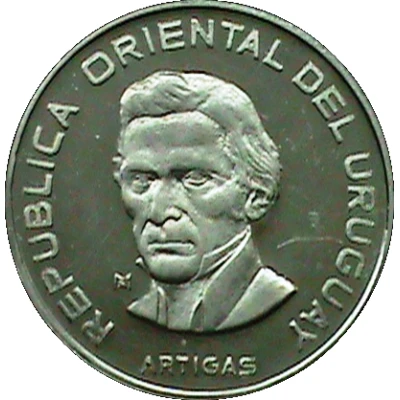


© Mauricio Peralta
1000 Pesos FAO
1969 year| Silver (.900) | 25 g | 37 mm |
| Issuer | Uruguay |
|---|---|
| Period | Oriental Republic of Uruguay (1825-date) |
| Type | Circulating commemorative coin |
| Year | 1969 |
| Value | 1000 Pesos (1000 UYP) |
| Currency | Peso (1863-1975) |
| Composition | Silver (.900) |
| Weight | 25 g |
| Diameter | 37 mm |
| Thickness | 2.5 mm |
| Shape | Round |
| Technique | Milled |
| Orientation | Medal alignment ↑↑ |
| Demonetized | 4 April 1972 |
| Updated | 2024-10-09 |
| Numista | N#23255 |
|---|---|
| Rarity index | 19% |
Reverse
Assorted stylized designs within circle (See coments below)
Script: Latin
Lettering:
• F A O •
FIAT 1969 PANIS
Translation:
F.A.O. (Food and Agriculture Organization)
FIAT PANIS: Latin= Make food
1969
Engraver: Francisco Matto Vilaró
Edge
Inscripted
Script: Latin
Lettering: REPUBLICA ORIENTAL DEL URUGUAY So
Translation: Oriental Republic of Uruguay So (Santiago mintmark)
Comment
This coin was created to adhere to the numismatic FAO program and is present on sets "Food for All" (Panel 2A) and FAO Album (page 9). The design is based upon the esthetical style created by the uruguayan artist Joaquin Torres Garcia (known as "Constructive Universalism" or "Constructivism").On the obverse shows a Sun, Constuctivist version, and on reverse several symbols. Torres Garcia thought art should not copy nature, but not negate it either. Symbols are modern, but also remind native symbolism. They are so simple and bidimensionals, that evocate primitive art, and are very easy to understand them, main are: the fish (Nature), the triangle (Reason), the heart (feelings), man and woman.
Meanings of the symbols on reverse:
1: Creator's Face; 2: carpenter's square; 3: Universal Man, no races; 4: eel (representing sea element; 5: oxen yoke ; 6: seeds; 7: bird and seed; 8: fruit tree branch; 9: shovel; 10: buoy (fishing stuff); 11: tray to keep water and a seed; 12: fruit tree stakes; 13: axe; 14: ploughshare; 15: cow and seed; 16: lizzard; 17: grinding grain mortar.
There is a variant of this coin, where there is a small line from left eye of the Sun on obverse towards the nose; is known as "teardrop".
No teardrop variant Teardrop variant
Also some coins have the inscription that can be read with obverse up, and others with reverse up; so combining teardrop/no teardrop and reading up/down, it makes a total of 4 variants.
Teardrop is not described in main catalogues, but frequently is mentioned in auction sites. Position of edge inscription is rarely described.
Mintmark is placed on edge.
NOTE:
- On 1987, Central Bank of Uruguay countermarked (off centered) 2 000 coins as celebration of Bank's 20th. anniversary;
- On 1997, Central Bank of Uruguay countermarked (centered and colorized) 500 coins as celebration of Bank's anniversary.
- Krause listed countermarked coins on original year, adding letter (KM# 55c and KM# 55d);
- SA did not list them separately, and only added a note explaining the countermarked coins;
- CG listed countermarked coins as variants (original= GC# 96.1; countermarked= CG# 96.2 & CG# 96.3); also lists silver pattern separately (CG# E34)
Interesting fact
One interesting fact about this coin is that it was minted to commemorate the 25th anniversary of the Food and Agriculture Organization (FAO) of the United Nations, which is headquartered in Rome, Italy. The coin's design features the FAO's emblem on one side and the Uruguayan coat of arms on the other. This coin is a unique piece of numismatic history that not only serves as a reminder of Uruguay's participation in the FAO but also showcases the country's rich history and culture.
Price
| Date | Mintage | VG | F | VF | XF | AU | UNC |
|---|---|---|---|---|---|---|---|
| 1969 So | 497500 | - | - | - | - | - | - |
Values in the table are based on evaluations by sales realized on Internet platforms. They serve as an indication only for 1000 Pesos (FAO) 1969 coin.



